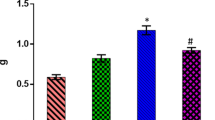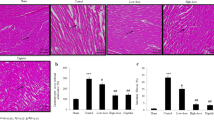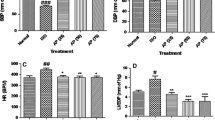Abstract
Consumption of diets rich in flavonoids is associated with reduced risk of cardiovascular diseases such as myocardial infarction. Cardiotoxicity was induced in rats by subcutaneous injection of isoproterenol at an interval of 24 h for 2 days. Isoproterenol-induced rats showed a significant increase in the levels of heart mitochondrial lipids, lipid peroxidation products, calcium and a significant decrease in the activities/levels of mitochondrial antioxidants, enzymes and adenosine triphosphate. Isoproterenol-induced rats also showed an increase in the intensities of serum lactate dehydrogenase-1 and 2 isoenzyme bands. Pretreatment with rutin at the dose of 80 mg/kg daily for 42 days to isoproterenol-induced rats prevented all the biochemical alterations. Transmission electron microscopic study also confirmed the protective effects of rutin on the structure of heart mitochondria. Thus, rutin reduced the extent of mitochondrial damage induced by isoproterenol and prevented cardiac mitochondrial dysfunction. The possible mechanisms for the observed effects of rutin could be due to scavenging free radicals, lowering lipid peroxides, lipids and calcium, improving multienzyme activities, glutathione levels, adenosine triphosphate levels, thereby improving cardiac mitochondrial structure and function. This study may have a significant impact on myocardial infarcted patients.





Similar content being viewed by others

References
Mohanty, I., Arya, D. S., Dinda, A., Talwar, K. K., Joshi, S., & Gupta, S. K. (2004). Mechanisms of cardioprotective effect of Withania somnifera in experimentally induced myocardial infarction. Basic and Clinical Pharmacology and Toxicology, 94, 184–190.
Sushama Kumari, S., Jayadeep, A., Kumar, J. S., & Menon, V. P. (1989). Effect of carnitine on malondialdehyde, taurine and glutathione levels in heart of rats subjected to myocardial stress by isoproterenol. Indian Journal of Experimental Biology, 27, 134–137.
Chein, K. R., Abrams, J., Serroni, A., Martin, J. T., & Farber, J. L. (1978). Accelerated phospholipid degradation and associated membrane dysfunction in irreversible, ischemic liver cell injury. Journal of Biological Chemistry, 253, 4809–4817.
Geng, B., Chang, L., Pan, C., Qi, Y., Zhao, J., Pang, Y., et al. (2004). Endogenous hydrogen sulfide regulation of myocardial injury induced by isoproterenol. Biochemical and Biophysical Research Communications, 318, 756–763.
Banerjee, S. K., & Maulik, S. K. (2002). Effect of garlic on cardiovascular disorders: A review. Nutrition Journal, 1, 4.
Hertog, M. G., Hollman, P. C., Katan, M. B., & Kromhout, D. (1993). Intake of potentially anticarcinogenic flavonoids and their determinants in adults in The Netherlands. Nutrition and Cancer, 20, 21–29.
Janbaz, K. H., Saeed, S. A., & Gilani, A. H. (2002). Protective effect of rutin on paracetamol- and CCl4-induced hepatotoxicity in rodents. Fitoterapia, 73, 557–563.
Stanely Mainzen Prince, P., & Karthick, M. (2007). Preventive effect of rutin on lipids, lipoproteins and ATPases in isoproterenol-induced myocardial infarction in rats. Journal of Biochemical and Molecular Toxicology, 21, 1–6.
Karthick, M., & Stanely Mainzen Prince, P. (2006). Preventive effect of rutin, a bioflavonoid, on lipid peroxides and antioxidants in isoproterenol-induced myocardial infarction in rats. Journal of Pharmacy and Pharmacology, 58, 701–707.
Takasawa, M., Hayakawa, M., Sugiyama, S., Hattori, K., Ito, T., & Ozawa, T. (1993). Age-associated damage in mitochondrial function in rat hearts. Experimental Gerontology, 28, 269–280.
Zlatkis, A., Zak, B., & Boyle, A. J. (1953). A new method for the direct determination of serum cholesterol. Journal of Laboratory and Clinical Medicine, 41, 486–492.
Fossati, P., & Prencipe, L. (1982). Serum triglycerides determined colorimetrically with an enzyme that produces hydrogen peroxide. Clinical Chemistry, 28, 2077–2080.
Falholt, K., Lund, B., & Falholt, W. (1973). An easy colorimetric micromethod for routine determination of free fatty acids in plasma. Clinica Chimica Acta, 46, 105–111.
Fraga, C. G., Leibovitz, B. E., & Tappel, A. L. (1988). Lipid peroxidation measured as thiobarbituric acid-reactive substances in tissue slices: Characterization and comparison with homogenates and microsomes. Free Radical Biology and Medicine, 4, 155–161.
Kakkar, P., Das, B., & Viswanathan, P. N. (1984). A modified spectrophotometric assay of superoxide dismutase. Indian Journal of Biochemistry and Biophysics, 21, 130–132.
Sinha, A. K. (1972). Colorimetric assay of catalase. Analytical Biochemistry, 47, 389–394.
Rotruck, J. T., Pope, A. L., Ganther, H. E., Swanson, A. B., Hafeman, D. G., & Hoekstra, W. G. (1973). Selenium: Biochemical role as a component of glutathione peroxidase. Science, 179, 588–590.
Ellman, G. L. (1959). Tissue sulfhydryl groups. Archives of Biochemistry and Biophysics, 82, 70–77.
King, J. (1965). Isocitrate dehydrogenase. In J. C. King & D. Van (Eds.), Practical clinical enzymology (p. 363). London: Nostrand.
Slater, E. C., & Borner, W. D. (1952). The effect of fluoride on the succinic oxidase system. Biochemical Journal, 52, 185–196.
Mehler, A. H., Kornberg, A., Crisolia, S., & Ochoa, S. (1948). The enzymatic mechanism of oxidation-reductions between malate or isocitrate and pyruvate. Journal of Biological Chemistry, 174, 961–977.
Reed, L. J., & Mukherjee, R. B. (1969). α-Ketoglutarate dehydrogenase complex from Escherichia coli. In J. M. Lowenstein (Ed.), Methods in enzymology (pp. 53–61). London: Academic Press.
Minakami, S., Ringler, R. L., & Singer, T. P. (1962). Studies on the respiratory chain-linked dihydrodiphosphopyridine nucleotide dehydrogenase. I. Assay of the enzyme in particulate and in soluble preparations. Journal of Biological Chemistry, 237, 569–576.
Pearl, W., Cascarano, J., & Zweifach, B. W. (1963). Microdetermination of cytochrome oxidase in rat tissues by oxidation of N-phenlyl-p-phenylene diamine or ascorbic acid. Journal of Histochemistry and Cytochemistry, 11, 102–107.
Williams, J. R., & Coorkey, B. E. (1967). Assay of intermediates of the citric acid cycle and related compounds by flourimetric enzymatic methods. In J. M. Lowenstein (Ed.), Methods in enzymology (pp. 488–492). New York: Academic Press.
Lowry, O. H., Rosebrough, N. J., Farr, A. L., & Randall, R. J. (1951). Protein measurement with Folin’s phenol reagent. Journal of Biological Chemistry, 193, 265–275.
McKenzie, D., & Henderson, A. R. (1983). Electrophoresis of lactate dehydrogenase isoenzymes. Clinical Chemistry, 29, 189–195.
Nishikimi, M., Appaji, N., & Yagi, K. (1972). The occurrence of superoxide anion in the reaction of reduced phenazine methosulfate and molecular oxygen. Biochemical and Biophysical Research Communications, 46, 849–854.
Halliwell, B., Gutteridge, J. M., & Aruoma, O. I. (1987). The deoxyribose method: A simple “test-tube” assay for determination of rate constants for reactions of hydroxyl radicals. Analytical Biochemistry, 165, 215–219.
Belchenko, D. I., Sopka, N. V., Kalinkin, M. N., Khanina, N. I. A., & Chelnokov, V. S. (1990). The metabolic changes in myocardial subcellular fractions in the pathogenesis of ischemic heart disease. Patologicheskaia Fiziologiia i Eksperimentalnaia Terapiia, 2, 16–20.
Vijayapadma, V., & Shyamaladevi, C. S. (2001). Effect of fish oil on mitochondrial respiration in isoproterenol induced myocardial infarction in rats. Indian Journal of Experimental Biology, 40, 268–272.
Yogeeta, S. K., Raghavendran, H. R., Gnanapragasam, A., Subhashini, R., & Devaki, T. (2006). Ferulic acid with ascorbic acid synergistically extenuates the mitochondrial dysfunction during beta-adrenergic catecholamine induced cardiotoxicity in rats. Chemico-Biological Interactions, 163, 160–169.
Pietta, P. G. (2000). Flavonoids as antioxidants. Journal of Natural Products, 63, 1035–1042.
Spencer, J. P., Jenner, A., Aruoma, O. I., Evans, P. J., Kaur, H., Dexter, D. T., et al. (1994). Intense oxidative DNA damage promoted by L-dopa and its metabolites. Implications for neurodegenerative disease. FEBS Letters, 353, 246–250.
Bokkenheuser, V. D., Shackleton, C. H., & Winter, J. (1987). Hydrolysis of dietary flavoniod glycosides by strains of intestinal Bacteroides from humans. Biochemical Journal, 248, 953–956.
Ueno, I., Nakano, N., & Hirono, I. (1983). Metabolic fate of [14C] quercetin in the ACI rats. Japanese Journal of Experimental Medicine, 53, 41–50.
Hollman, P. C. H., & Katan, M. B. (1996). Absorption, metabolism and bioavailability of flavonoids. In C. Rice-Evans, L. Packer (eds.), Flavonoids in health and diseases (pp. 483–522) New York.
Boyle, S. P., Dobson, V. L., Duthie, S. J., Hinselwood, D. C., Kyle, J. A., & Collins, A. R. (2000). Bioavailability and efficiency of rutin as an antioxidant: A human supplementation study. European Journal of Clinical Nutrition, 54, 774–782.
Erlund, I., Kosonen, T., Alfthan, G., Maenpaa, J., Perttunen, K., Kenraali, J., et al. (2000). Pharmacokinetics of quercetin from quercetin aglycone and rutin in healthy volunteers. European Journal of Clinical Pharmacology, 56, 545–553.
Author information
Authors and Affiliations
Corresponding author
Rights and permissions
About this article
Cite this article
Punithavathi, V.R., Shanmugapriya, K. & Stanely Mainzen Prince, P. Protective Effects of Rutin on Mitochondrial Damage in Isoproterenol-Induced Cardiotoxic Rats: An In Vivo and In Vitro Study. Cardiovasc Toxicol 10, 181–189 (2010). https://doi.org/10.1007/s12012-010-9077-8
Published:
Issue Date:
DOI: https://doi.org/10.1007/s12012-010-9077-8



